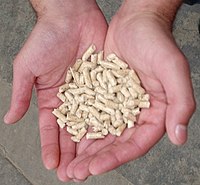
Photo from wikipedia
Abstract Based on the multiphase particle-in-cell approach, the steam gasification of biomass in a lab-scale spouted bed gasifier is simulated to explore the particle-scale transport behavior in three distinct regions… Click to show full abstract
Abstract Based on the multiphase particle-in-cell approach, the steam gasification of biomass in a lab-scale spouted bed gasifier is simulated to explore the particle-scale transport behavior in three distinct regions of the bed. The numerical results are firstly validated with the experimental data, followed by assessing the particle-scale features of sand and biomass species in the gasifier. The results demonstrate that biomass particles in three regions of spouted bed behave with different constituent content, heat transfer coefficient and temperature. The intensive heat transfer occurs in the spout region and fountain region. Biomass particles in the spout have a small temperature, large mass, small carbon fraction, and large volatile fraction. Heterogeneous reactions of the biomass particles mainly occur in the lower part of the fountain region but can be negligible in the spout and annulus region. The water-gas reaction is two-order of magnitude faster than the methanation reaction and Boudouard reaction. The spatial distribution of particle-scale level information of both particle species is nonuniform due to the presence of three regions and biomass accumulation. The horizontal and vertical dispersion coefficient of both sand and biomass species are at the scale of 10−4 m2/s and 10−2 m2/s, respectively.
Journal Title: Renewable Energy
Year Published: 2020
Link to full text (if available)
Share on Social Media: Sign Up to like & get
recommendations!